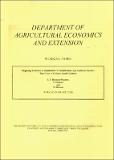| dc.contributor.author | Hanyani-Mlambo, B.T. | |
| dc.contributor.author | Sibanda, S. | |
| dc.contributor.author | Rukuni, Mandivamba | |
| dc.coverage.spatial | Zimbabwe. | en |
| dc.date.accessioned | 2015-09-15T11:23:58Z | |
| dc.date.available | 2015-09-15T11:23:58Z | |
| dc.date.issued | 2000-03 | |
| dc.identifier.citation | Hanyani-Mlambo, B.T., Sibanda, S. and Rukuni, M. (2000) Farming systems in Zimbabwe’s smallholder agricultural sector: the case of Gokwe South District. AEE Working Paper no. 2/2000. UZ, Mt. Pleasant, Harare: DAEE. | en |
| dc.identifier.uri | https://opendocs.ids.ac.uk/opendocs/handle/20.500.12413/7046 | |
| dc.description | A Working Paper on the smallholder agriculture sector in a rural area of Zimbabwe | en |
| dc.description.abstract | Farming systems in Gokwe South District today are essentially the product of interactions between local indigenous cultivation systems and external interventions. Dryland crop production is the major income generating activity in the area. The major food crops are maize and groundnuts, while cotton and sunflower are the major cash crops. Through the years, changes in bio-physical conditions and population densities have led to a shift from traditional staples such as sorghum and millet to dominant grains, notably, maize. The introduction of a market economy and cash crops in local farming systems has also resulted in local crop production systems moving away from a purely subsistence activity to a partially commercialized industry. Livestock is an integral part of all smallholder farming systems, with cattle constituting the bulk of domesticated animals. Indigenous beef cattle constitute the bulk of cattle kept by individual households. However, farmers' current projections portray a trend of declining indigenous stock, accompanied by an increase in the commercial dairy herd size. The major identified constraints include unfavourable geo-physical conditions, an inadequate, resource base, restricted access, to inputs, labour bottlenecks, pests and diseases, inappropriate post-harvest technology’, poor animal nutrition, poor animal health delivery systems, under-utilised genetic potential, insufficient infrastructure for disposal of marketable produce, and lack of institutional support. | en |
| dc.language.iso | en | en |
| dc.publisher | Department Of Agricultural Economics and Extension (DAEE) (University of Zimbabwe) (UZ) | en |
| dc.relation.ispartofseries | Working Paper AEE;2/2000 | |
| dc.rights.uri | http://creativecommons.org/licenses/by-nc-nd/3.0/ | en |
| dc.subject | Agriculture | en |
| dc.subject | Rural Development | en |
| dc.title | Farming systems in Zimbabwe’s smallholder agricultural sector: the case of Gokwe South District | en |
| dc.type | Series paper (non-IDS) | en |
| dc.rights.holder | University of Zimbabwe (UZ) | en |


